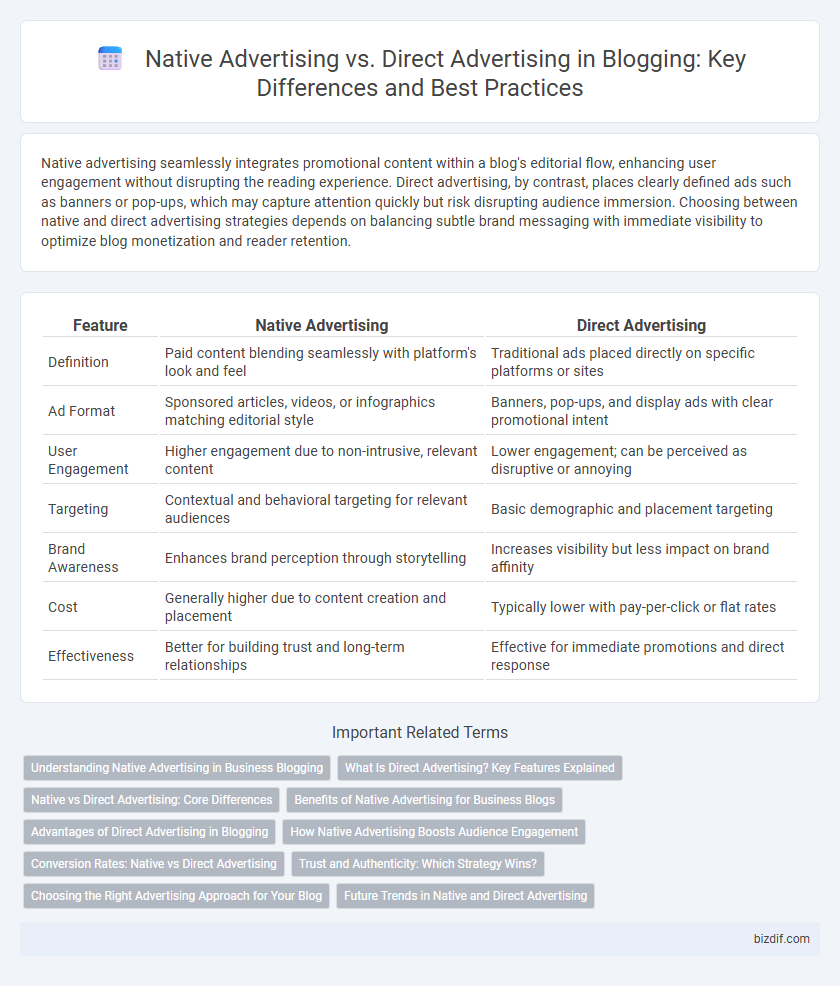Native advertising seamlessly integrates promotional content within a blog's editorial flow, enhancing user engagement without disrupting the reading experience. Direct advertising, by contrast, places clearly defined ads such as banners or pop-ups, which may capture attention quickly but risk disrupting audience immersion. Choosing between native and direct advertising strategies depends on balancing subtle brand messaging with immediate visibility to optimize blog monetization and reader retention.
Table of Comparison
| Feature | Native Advertising | Direct Advertising |
|---|---|---|
| Definition | Paid content blending seamlessly with platform's look and feel | Traditional ads placed directly on specific platforms or sites |
| Ad Format | Sponsored articles, videos, or infographics matching editorial style | Banners, pop-ups, and display ads with clear promotional intent |
| User Engagement | Higher engagement due to non-intrusive, relevant content | Lower engagement; can be perceived as disruptive or annoying |
| Targeting | Contextual and behavioral targeting for relevant audiences | Basic demographic and placement targeting |
| Brand Awareness | Enhances brand perception through storytelling | Increases visibility but less impact on brand affinity |
| Cost | Generally higher due to content creation and placement | Typically lower with pay-per-click or flat rates |
| Effectiveness | Better for building trust and long-term relationships | Effective for immediate promotions and direct response |
Understanding Native Advertising in Business Blogging
Native advertising in business blogging seamlessly integrates sponsored content that matches the blog's tone and style, enhancing reader engagement without disrupting user experience. This approach builds trust by delivering relevant information that aligns with audience interests, resulting in higher click-through rates compared to traditional direct advertising. Businesses leveraging native ads achieve improved brand visibility and customer loyalty by embedding promotional messages naturally within valuable blog content.
What Is Direct Advertising? Key Features Explained
Direct advertising involves promoting products or services through explicit, targeted messages delivered directly to potential customers via channels such as email, social media ads, or search engine marketing. Key features include clear calls to action, measurable ROI through tracking clicks and conversions, and tailored content designed to engage specific audience segments. This approach contrasts with native advertising by emphasizing straightforward promotion rather than blending seamlessly with editorial content.
Native vs Direct Advertising: Core Differences
Native advertising seamlessly integrates promotional content within the natural flow of a blog, matching the style and tone to create a non-disruptive user experience, whereas direct advertising is clearly distinct, often appearing as banner ads or pop-ups that explicitly promote a product or service. Native ads leverage contextual relevance and subtle messaging to engage readers, while direct ads prioritize visibility and immediate call-to-action effectiveness. The core difference lies in the user engagement strategy: native advertising aims for immersive, less intrusive content integration, whereas direct advertising focuses on overt promotion and quick response.
Benefits of Native Advertising for Business Blogs
Native advertising seamlessly integrates promotional content within a business blog's editorial environment, enhancing user experience and increasing engagement rates by delivering relevant and non-disruptive messages. Compared to direct advertising, native ads drive higher click-through and conversion rates due to their contextual relevance and subtlety, fostering stronger brand trust and longer audience retention. This approach also improves SEO performance by aligning sponsored content with organic topics, boosting visibility and attracting targeted traffic to business websites.
Advantages of Direct Advertising in Blogging
Direct advertising in blogging offers precise audience targeting by leveraging detailed user data and platform analytics, ensuring ads reach the most relevant readers. It enables bloggers to maintain full control over ad messaging and design, fostering authentic brand representation and stronger engagement. Higher transparency and measurable ROI make direct advertising a preferred choice for businesses seeking effective, accountable marketing solutions.
How Native Advertising Boosts Audience Engagement
Native advertising boosts audience engagement by seamlessly integrating promotional content within the user experience, making ads appear less intrusive and more relevant. Unlike direct advertising, which often disrupts content flow with overt messaging, native ads maintain the platform's look and feel, increasing viewer interaction and time spent on content. This subtle yet strategic approach enhances brand credibility and fosters deeper connections with target audiences.
Conversion Rates: Native vs Direct Advertising
Native advertising typically yields higher conversion rates by seamlessly integrating promotional content with the user experience, increasing engagement and trust. Direct advertising often achieves quicker results through clear, targeted calls-to-action but may face ad fatigue or banner blindness, reducing effectiveness. Analyzing industry benchmarks reveals native ads can boost conversions by up to 30% compared to traditional direct ads, especially in content-driven platforms.
Trust and Authenticity: Which Strategy Wins?
Native advertising integrates seamlessly within content, enhancing trust by matching the platform's tone and style, whereas direct advertising often risks appearing intrusive and less authentic. Consumer engagement and brand credibility typically increase with native ads due to their subtle, non-disruptive approach. Studies confirm that audiences respond more positively to native advertising, perceiving it as a trustworthy source compared to overt direct ads.
Choosing the Right Advertising Approach for Your Blog
Native advertising seamlessly integrates promotional content within your blog's editorial flow, enhancing user experience and engagement by matching the style and tone of your posts. Direct advertising offers clear, distinct promotional messages such as banner ads or sponsored posts, providing straightforward brand visibility and measurable performance metrics. Choosing the right approach depends on your blog's niche, audience preferences, and goals for monetization and content authenticity.
Future Trends in Native and Direct Advertising
Future trends in native advertising emphasize seamless integration with content through AI-driven personalization and interactive formats, enhancing user engagement and brand authenticity. Direct advertising is evolving with programmatic buying and data analytics, enabling precision targeting and real-time campaign optimization across multiple digital platforms. Both approaches will increasingly leverage augmented reality and immersive experiences to captivate audiences and drive measurable ROI.
Native Advertising vs Direct Advertising Infographic

 bizdif.com
bizdif.com